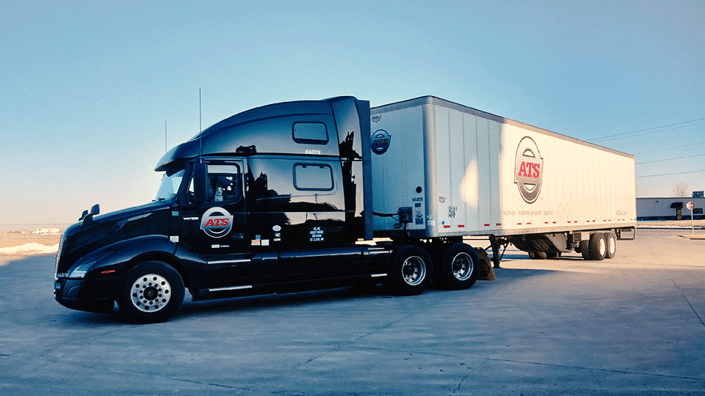
The last few months have been challenging for the world as a whole. Among other things, the impact of international conflicts, continued labor shortages and the ongoing COVID-19 pandemic, have exacerbated the supply-chain-congestion issues that began at the onset of 2020.
As a result, businesses with cargo to move have been forced to navigate unprecedented volatility to do so. Many companies have been at a decided disadvantage as securing consistent capacity proves problematic and budgeting for these costs becomes more so.
Shippers aren’t the only ones weathering a storm, however; trucking companies, responsible for more than 70 percent of total freight transport in the U.S. alone, have also faced difficulties.
Recently (in late February 2022), fuel prices began a steep upward climb, stoking this fire further and impacting both trucking companies and shippers alike.
At Anderson Trucking Service (ATS), we understand the predicament businesses, like yours, are in; you can’t control the price of fuel, but want to ensure you’re paying appropriate freight rates all the while.
In this article, we’ll explain the impact fuel costs have on freight movement, by answering the following questions:
- How far have fuel prices risen lately?
- How do rising fuel costs impact trucking companies?
- How do trucking companies calculate your fuel surcharge?
- How do rising fuel costs impact the freight rates you receive?
- How can you take your budget further in volatile times?
Although we can’t give you a glimpse of what the future holds for freight rates or prices at the pump, we can help you weather this storm. With the correct understanding and expectations, you’ll be better prepared to successfully facilitate your supply chain going forward.
How Far Have Fuel Prices Risen Lately?
U.S. retail diesel prices— the average per-gallon price individuals pay to purchase diesel fuel in the U.S. — have been on an upward trajectory since early January 2022.
On January 3, the average per-gallon diesel price was $3.61, a price point that, although high, set no historical landmark.
A little over seven weeks later, though, on February 28, purchasing a gallon of diesel fuel cost $4.10, representing a steady increase that has only continued to climb.
At its 52-week high, which happened on March 14, 2022, U.S. retail diesel prices surpassed $5 per gallon for the first time, peaking at an average of $5.25 (a more than 60 percent increase compared to one year prior).
Although this fuel price reflects the average price for a gallon of diesel across the U.S. and fluctuates by area/region, states like California and Washington (which hold highly-specific fuel standards) boast diesel prices near or above $6 per gallon — dragging this average up — these prices have impacted and will continue to impact, supply chains around the globe.
How Do Rising Fuel Costs Impact Trucking Companies?
For trucking companies, purchasing diesel fuel is one of the largest expenses associated with operation. Like equipment replacement/maintenance costs and insurance premiums, fuel prices are out of every carrier’s control and unavoidable.
There is nothing — short of leaving the industry — trucking companies can do to mitigate fuel expenses. As they rise, trucking companies (and their drivers) are forced to increase the prices they charge customers in order to remain in business.

You see, without doing so, carriers would be forced out of business by dedicating potential profits to filling their tanks and never realizing meaningful gains.
Recently, this has become an even larger issue for small trucking companies that simply don’t have the financial backing to weather this ever-intensifying storm.
How Do Trucking Companies Calculate Your Fuel Surcharge?
To balance ever-changing fuel costs, asset carriers and shippers typically agree to a fuel surcharge program when they enter into a contract. These fuel charges, which are typically billed in addition to the line-haul rates shippers receive, are meant to compensate drivers for the money they spend purchasing fuel while hauling a load.
These charges, of course, have risen greatly over the past few months.
To further this point, here is a quick “fuel math” scenario:
Let’s say you have to move a load from San Antonio to Amarillo, Texas — a trip of 500 miles.
Since semi-trucks get an average of 6.5 miles per gallon, we know that this one-way trip will take around 77 gallons of diesel fuel.
Now, the average price per gallon of fuel in Texas (as of 3/28/22) is $4.246. By multiplying this price point by the number of gallons used on a 500-mile run in Texas, you should expect to pay around $327 in fuel for this shipment.
Here’s how this $327 stacks up against a couple of previous rates for the same shipment.
As of February 28, 2022:
| Average cost of diesel | Gallons used | Average cost of diesel |
| $3.73 | 77 | $287.28 |
As of March 28, 2021:
| Average cost of diesel | Gallons used | Total fuel charge |
| $2.85 | 77 | $219.68 |
As you can see, the fuel cost of moving this same load in February, were significantly lower than they currently are — a frustrating fact for many shippers.
This pattern holds across the U.S. as rising fuel prices cannot be avoided and trucking companies must accurately compensate drivers.
Understanding how your shipment’s distances and accompanying fuel costs will impact the price of moving it, however, will play to your benefit long term. Bookmark this truck fuel cost calculator for a quick-reference tool going forward.
How Do Rising Fuel Costs Impact The Freight Rates You Receive?
At the end of the day, every trucking company and shipper is subject to the same reality: although fuel prices are rising, in the end, drivers aren’t responsible for footing this bill.
Sure, as a shipper, there are several ways for you to handle your freight payments. That said, whether you decide to pay for fuel separately (as a surcharge) or together with your line-haul rate(s), the final amount of money you spend will rise to match higher diesel prices.

As 2022 continues, expect some rate volatility to accompany your shipments. Ask your transportation providers for breakdowns of your fuel charges and cross-reference this information with what you now understand. Although there’s little you can do where fuel prices are concerned, you’ll enjoy the peace of mind that accompanies knowing where your rates are coming from.
Tips For Taking Your Budget Further In Volatile Times
We get it, all this talk about rising fuel pricing being out of your control can be frustrating. With so much on the line for your business and customers, your desire to properly manage your transportation spending is far from unreasonable.
The best advice we can give you here is this: control what you can.
Often, the easiest way for companies to cut down their freight costs is right under their noses and completely in their control.
Here are three things, in your control, that you should look to prioritize as we continue to battle fuel prices:
- Make your freight as appealing as possible
- Be flexible on your requirements
- Offer your carriers plenty of lead time
#1: Make Your Freight as Appealing as Possible
The easier it is for trucking companies, and their drivers, to fit your load into their busy schedules, the better off you’ll be going forward. Amid an ongoing truck driver and equipment shortages — which continue to worsen — it’s getting increasingly difficult for trucking companies to meet demand.
As a result, carriers have had to become increasingly selective with the loads they service. Make sure your shipments are as driver-friendly as possible by doing some, or most of the following:
- Boasting efficient loading times
- Being clear about your cargo’s specifications
- Giving carriers comprehensive instructions to follow
- Offering truck driver amenities
- Offering overnight parking on site
- Managing your google reviews
Related: Reduce Your Freight Costs By Doing These 8 Things Truckers Enjoy
#2: Be Flexible With Your Requirements
A smidgen of flexibility goes a long way in the transportation industry, where rigidity is all too common. As you work to maximize your transportation budget in the weeks, months and years ahead, flexibility on equipment types and appointment times will serve you well.
You see, rigid transportation requirements — such as presenting a load as “flatbed only” or boasting an immovable 8 a.m. pickup time — give providers little room to work within and few options to consider.

When seeking services in an industry that’s currently experiencing supply deficiencies, rigid requirements will raise your freight rates.
Luckily, this is well within your control. Open yourself up to a wider pool of trailer-type options by giving your providers the dimensions of each shipment and allowing them to find a viable solution from the field. Allow your carrier greater range of motion in arranging a driver by offering a wider time frame for pickup/delivery. Each of these tactics will help you save money going forward.
Related: 4 Out-Of-The-Box Ways to Save Money on Your Freight Rates
#3: Offer Your Carriers Plenty of Lead Time
The third thing within your control that can make or break your transportation budget is the amount of lead time you give each carrier. By and large, trucking companies are busy — and they’re only getting more so.
For this reason, in the interest of securing truck capacity at competitive price points, make sure to give proper notice to the companies in your network. Although it varies from one shipment to the next, providing notice 24-72 hours in advance of the moment your freight needs to load will ensure proper pricing. Smaller-window loads (like same-day shipments) end up being far more expensive than those with proper lead time.
Related: How Does Lead Time Impact Freight Shipping Cost?
Get to Know Your Freight Rates Intimately and Save
With a firm grasp on how rising fuel rates impact transportation companies and, by extension, the price you pay to move freight, you’re better suited for when these charges rise and fall.
That said, the price of fuel isn’t the only thing driving your shipping quotes. The better you understand the core factors impacting the rates you receive the better.
Here at ATS, we’re intimately familiar with all kinds of freight pricing and have compiled some comprehensive articles that outline each. Check them out below and get to know your freight rates a little bit better.
| What Does Heavy Haul Trucking Cost? | What Does Dry Van Shipping Cost? |
| What Does Flatbed Shipping Cost? | What Does International Shipping Cost? |
Finally, if you have any questions about how ATS can help you manage your shipments going forward, feel free to contact us today. We have a seasoned transportation professional ready and willing to help you become the supplier that always delivers!




